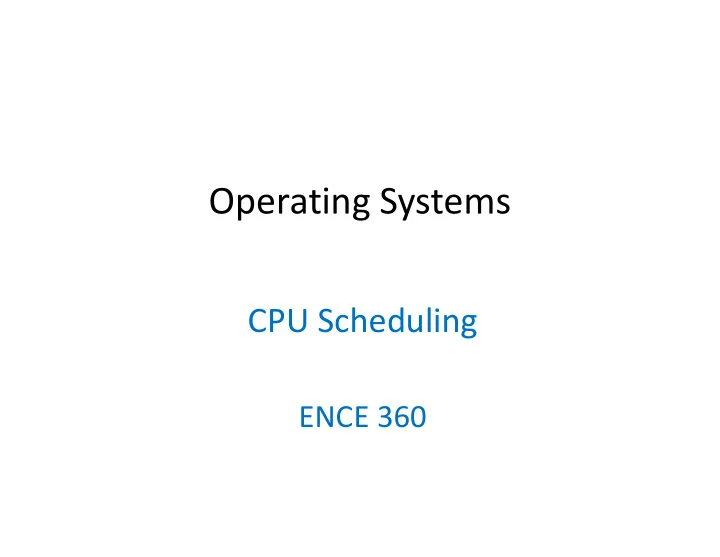

Operating Systems CPU Scheduling ENCE 360
Operating System Schedulers Short-Term Long-Term (batch) Medium-Term “Which Ready process to “Which requested process “Which Ready process to Running ?” into Ready Queue?” memory?” CPU Scheduler Admission scheduler Memory scheduler This deck about CPU scheduler
Outline • Introduction (done) • Scheduling Policies (next) – FIFO – SJF – SCTF – RR – SOS – MLFQ • Other topics Chapter 2.4 Chapters 7 & 8 MODERN OPERATING SYSTEMS (MOS) OPERATING SYSTEMS: THREE EASY PIECES By Andrew Tanenbaum By Arpaci-Dusseau and Arpaci-Dusseau
A CPU Scheduling Scenario • Assume: 1. Fixed number of processes 2. All “ready” at same time 3. Non-preemptive scheduling 4. All need same processing time Ready 5. No process use I/O • Have: – 3 process (A, B, C) ? Running What is simplest Each needs 10 seconds of CPU policy?
First In, First Out – Easy, Peasy! Average turn around time = (10 + 20 + 30) / 3 = 10 Relax assumption #4 (equal time). When might this perform poorly?
First In, First Out – Uh, oh! The “convoy” affect Average turn around time = (100 + 110 + 120) / 3 = 110 How to do better? (Hint: think about grocery stores)
Shortest Job First (SJF) Job = Process Given assumptions, SJF is provably optimal Average turn around time = (120 + 10 + 20) / 3 = 50 Relax assumption #2 (same starting time). When might this perform poorly?
Shortest Job First – Uh, oh! Average turn around time = (100 + 110-10 + 120-10) / 3 = 103 Relax assumption #3 (pre-emption). How can we make this better?
Shortest Time-to-Completion First (STCF) Given assumptions, provably optimal Average turn around time = (120-0 + 20-10 + 30-20) / 3 = 50 What if we consider users in interactive system? In other words, instead of turnaround time, what might they want?
Response Time Woes Average response time = (0 + 5 + 10) / 3 = 5 How can we make response time better?
Round Robin (RR) to the Rescue! Average response time = (0 + 5 + 10) / 3 = 5 “time slice” Average response time = (0 + 1 + 2) / 3 = 1 Let’s relax assumption #5 – of course processes do I/O!
RR Plays Nicely with I/O, Too!! No Round Robin Round Robin (with overlap) How big should time slice be? What are tradeoffs?
Scheduling – Process Behavior • Broadly, two kinds of processes a. CPU-bound b. I/O-bound Which kind are there more of?
Scheduling – Process Behavior I/O Bound Processes add read How long should Frequency RR timeslice be? (I/O Wait) store increment write (I/O Wait) Burst Duration
Scheduling – Process Behavior I/O Bound Processes add “knee” read in curve Frequency (I/O Wait) store increment write (I/O Wait) Burst Duration Set timeslice so most I/O bound processes finish in once slice Still protects against CPU bound!
SOS: Dispatcher See: “ dispatcher.c ” • What scheduling policy does it follow? • There is no “ return ” from Dispatcher() … Why not? – Hint: think of the OS system stack • There is a while(1); This is an infinite loop! … Why is this ok? – Hint: consider other options
Outline • Introduction (done) • Scheduling Policies – FIFO (done) – SJF (done) – SCTF (done) – RR (done) – SOS (done) – MLFQ (next) • Other topics
Priority Scheduling • Want system that is responsive – User enters commands, gets feedback • Want system that is efficient – Run processes to completion as quickly as possible THE CRUX OF THE PROBLEM: HOW TO SCHEDULE WITHOUT PERFECT KNOWLEDGE? Minimize response time for interactive processes AND minimize turnaround time for higher throughput, without a priori knowledge about burst length?
Priorities via Multi-Level Queue Rule 1: If A > B, then run A Rule 2: If A = B, then RR • Put interactive processes in high priority • Put long-running, CPU-bound processes in low priority • But … how do we know this? What if process changes? Need to “learn”, adapt based on behavior (feedback) Multi-level Feedback Queue
Adapt to Long Running Processes Rule 3: New process at highest priority (Long running process over time) Rule 4: If process uses all of slice, reduce priority
Prioritizes Short Processes (Short (interactive) process arrives) Rule 3: New process at highest priority Rule 4: If process uses all of slice, reduce priority
Supports I/O-Bound Processes (I/O Bound process makes progress) Problems? Hint: think of many interactive processes (Doesn’t interfere with CPU-bound process much)
I’m Starving! (Many short • Process may never get processes CPU (aka “starvation”) arrive) • And may have changed! – Was CPU-bound – Now I/O-bound Starvation! Fixes? Hint: movement does not have to be one-way
Gimme a Boost! Rule 5: after some time, all processes move to top Starvation! No boost Boost
Tuning Possible – e.g., Different Quanta Sizes for Improved Throughput Rule 6: timeslice inversely proportional to priority • Lots more possibilities! – Move up one level – Not RR for some queues …
Other Scheduling Topics • Linux http://www.cs.montana.edu/~chandrima.sark – Good overview ar/AdvancedOS/SchedulingLinux/index.html – Details • Completely Fair Scheduler https://en.wikipedia.org/wiki/ • sched_fair.c Completely_Fair_Scheduler • Windows https://www.microsoftpressst – Multi-level feedback queue ore.com/articles/article.aspx? – Starvation prevention p=2233328&seqNum=7 – Details Registers Registers • Multiprocessors CPU1 CPU1 – Chapter10 Mem OPERATING SYSTEMS: THREE EASY PIECES Disk By Arpaci-Dusseau and Arpaci-Dusseau
Outline • Introduction (done) • Scheduling Policies (done) – FIFO (done) – SJF (done) – SCTF (done) – RR (done) – SOS (done) – MLFQ (done) • Other Topics (done)
Recommend
More recommend